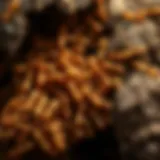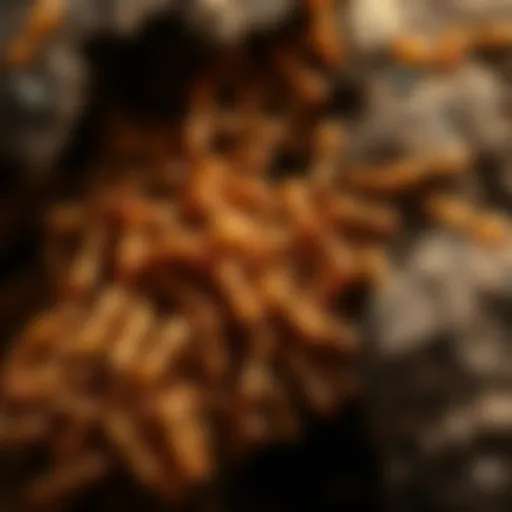Effective Pest Management Solutions in Greensboro
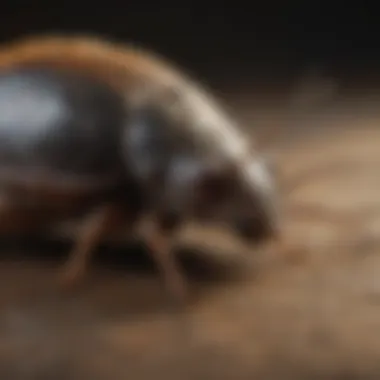

Intro
In Greensboro, the sight of uninvited guests creeping into your home can be quite unsettling. Be it an army of ants marching across your kitchen counter or the sudden chirping of crickets in the night, dealing with pests is a common challenge that many homeowners face. Engaging with exterminator services might seem daunting at first, but understanding how to navigate these services can turn an overwhelming task into an easier one. This article digs deep into the ins and outs of pest management in Greensboro, offering a clear road map packed with valuable information.
From identifying persistent nuisances to exploring treatment options, we'll cover every angle. With knowledge, homeowners can arm themselves against infestations, protecting their sanctuaries and ensuring a peaceful living environment.
Pest Identification
Recognizing the type of pest attempting to invade your home is the first and foremost step in tackling the problem. Not all pests are created equal, and understanding their traits can significantly influence the course of your action.
Detailed Descriptions of Common Pests
In Greensboro, several pests tend to be notorious for making unwanted appearances:
- Cockroaches: These resilient critters thrive in warm environments, often found in kitchens and bathrooms. They have a glossy, brown or black exterior and can rapidly multiply if left unchecked.
- Termites: Known as "silent destroyers," termites eat through wood from the inside out. They usually hide in the walls, making them hard to detect until significant damage has occurred.
- Ants: Various species of ants, such as fire ants or carpenter ants, can invade homes. Their nests of hundreds, sometimes thousands, can emerge in places like yards or inside walls.
- Rodents: Mice and rats are common in Greensboro, lured by shelter and food. They leave droppings and chew through materials, which can lead to property damage and health risks.
Signs and Symptoms of Infestations
Identifying an infestation early can save you both time and money. Look out for these signs:
- Droppings: Feces left behind by pests can be a clear indicator of their presence. The size and shape can help in identifying the type of pest.
- Nests or Tunnels: Finding nests made of shredded materials or dirt can signal a possible rodent or termite problem.
- Unusual Noises: Scratching sounds in walls or ceilings can indicate that rodents are scurrying about.
- Damage to Property: Gnawed wood, chewed wires, or holes in walls and bases often point toward a pest problem that needs immediate attention.
"Being proactive in pest identification can spare homeowners from the hassle and expenses associated with severe infestations."
Prevention Strategies
Once pests are identified, focusing on preventing them is crucial. Adopting a few practices around the home can make a difference.
Home Maintenance Tips for Pest Prevention
- Seal Entry Points: Cracks and crevices in doors and windows can serve as entryways for pests. Use caulk or weather stripping to seal off these potential access points.
- Proper Food Storage: Ensuring food is stored in airtight containers can reduce the attractiveness of your home to pests like ants and cockroaches.
- Regular Landscaping: Overgrown vegetation near the home can invite various pests. Keep bushes trimmed and remove debris that may provide shelter.
- Cleanliness is Key: Regular cleaning, especially in kitchens where food particles can attract pests, is vital.
Natural Deterrents and Barriers
Homeowners looking for a more eco-friendly approach have various options:
- Essential Oils: Oils like peppermint or tea tree oil are known to repel certain pests. A mixture can be sprayed around entry points.
- Vinegar Solutions: A combination of vinegar and water can deter pests like ants, as they are sensitive to its strong smell.
- Diatomaceous Earth: This natural powder can be spread in areas where pests frequent, damaging their exoskeletons without posing risks to humans or pets.
Treatment Options
If preventative measures are not enough and you have an infestation on your hands, understanding treatment options is essential.
Overview of Chemical vs. Natural Treatments
Though chemical treatments are often effective, some homeowners might opt for natural remedies, especially if they have young children or pets. Chemical treatments can provide quick results, but the long-term health effects can be concerning. On the other hand, natural methods may take longer but often come with fewer side effects.
Step-by-Step Guides for DIY Treatments
For those inclined to tackle the problem independently, following these steps can be effective:
- Identify the Pest: Use the information from the pest identification section to confirm what you’re dealing with.
- Choose Your Treatment: Decide on a chemical or natural approach. If going natural, consider using essential oils or vinegar solutions.
- Apply Treatment: Follow the instructions carefully for any chemical treatments or mix your natural deterrents correctly.
- Monitor Progress: Keep an eye on the affected areas. If you notice improvements or the situation worsening, adjust your tactics accordingly.
- Seek Professional Help if Needed: If you find the infestation persistent, don't hesitate to call in the experts.
Navigating exterminator services can be much clear, knowing the pests that plague Greensboro, prevention strategies, and treatment options available. By arming yourself with the right knowledge, you can effectively tackle pest issues, ensuring a comfortable living space.
Understanding the Pest Control Landscape
In the realm of home management, comprehending the pest control landscape isn't just a good idea—it's essential. Knowledge about pest control empowers homeowners to recognize the signs of an infestation early, tackle problems effectively, and ultimately keep their living spaces secure and comfortable. When one considers the range of pests that could invade their home—from seasonal insects like ants to year-round threats like rodents—the stakes are undoubtedly high.
By familiarizing oneself with pest control structures, one can differentiate between the various services available and determine what fits their specific needs. Understanding these nuances means not merely identifying a pest but also recognizing when professional help is warranted. This awareness can lead to better decisions which not only save money in the long run but also help maintain the home’s overall condition.
Overview of Pest Control
The pest control industry has evolved significantly over the years, moving away from one-size-fits-all solutions towards more tailored services. Today, pest control encompasses a broad range of techniques aimed at managing and eradicating pests while minimizing risks to humans and pets.
Key Elements of Pest Control
- Identification: Successful pest control begins with identifying the specific pest causing issues. Different insects and rodents demand distinct methods of treatment, and confusion can easily lead to ineffective solutions.
- Treatment Options: Depending on the pest, treatments may involve chemical extermination, natural remedies, or even more comprehensive strategies like Integrated Pest Management (IPM).
- Prevention: Understanding how and why pests invade is crucial to developing proactive measures. Simple things like sealing cracks and ensuring proper waste management can deter pests and avoid costly extermination down the line.


Engaging with pest control professionals allows homeowners to tap into specialized knowledge that isn’t typically found in DIY guides. This expertise is critical because what may seem like a pleasant summer day could also be a signal for pest migration into human homes.
Importance of Professional Extermination
Opting for professional extermination translates into benefiting from experience and expertise that average homeowners may lack. Many times, pests invade a home's inner workings, making it hard to detect or reach them.
Hiring a trained exterminator can yield numerous advantages:
- Comprehensive Inspections: Professionals often have access to technology and techniques that allow them to uncover hidden signs of infestations.
- Effective Solutions: They are equipped to use targeted treatments that homeowners might not be privy to, ensuring that the chosen method is not just quick but also effective. This is a significant factor considering the individual biology of various pests and the potential environmental impacts.
- Ongoing Management: Once pests are controlled, experts can provide guidance on maintaining pest-free mobility in the future.
"Pest control isn’t just about extermination; it’s part science, part strategy, and always about preserving the comfort of your home."
Common Pests in Greensboro
Understanding the typical pests in Greensboro is crucial for homeowners who want to protect their dwellings and maintain a comfortable living space. Ignoring the signs of pest infestations can lead to significant damage, both structurally and financially. Furthermore, some pests pose substantial health risks. By being informed about common pests, homeowners can take proactive measures to avoid infestations and engage exterminators effectively when pest issues arise.
Termites and Their Impact
Termites are infamous for wreaking havoc in homes, often munching away unnoticed. In Greensboro, the Eastern subterranean termite is prevalent. These little creatures can cause considerable destruction to wooden structures, potentially costing homeowners thousands of dollars in repairs. The tricky part is that termites often work in silence, nibbling away at the foundation or framing of a house without any visible signs until it’s too late.
Homeowners should watch for signs like mud tubes along walls or hollow-sounding wood. It’s wise to schedule annual inspections with professionals. If you catch it early, you can save a fortune.
Rodents: A Growing Concern
Rodents, particularly house mice and Norway rats, have become an increasing concern in Greensboro. Not only can they damage property by gnawing through wires and insulation, but they also carry various diseases that can affect humans. A rodent infestation can manifest through small droppings, nesting materials, and gnaw marks.
Preventative measures should include regular garbage disposal, sealing cracks in walls, and storing food in airtight containers. Likewise, if you suspect a rodent issue, acting promptly is essential. Exterminators can efficiently handle infestations and provide advice on keeping your home rodent-free.
Ant Species and Infestation Risks
Greensboro is home to numerous ant species, including carpenter ants, fire ants, and odorous house ants. Carpenter ants are particularly concerning, as they can destroy wooden structures similar to termites. Fire ants, while less destructive, deliver painful stings that can be a significant nuisance.
If you notice lines of ants marching across your kitchen counter, that's a red flag. Checking for ant trails and sealed food is a vital first step. An integrated approach to eradication is usually best, as different ant species may require tailored strategies to manage them effectively.
Bed Bugs: The Hidden Threat
Bed bugs are perhaps one of the most disliked pests for a good reason. These tiny insects feed on human blood and can create sleepless nights for homeowners. They can hitch a ride on luggage, clothing, or furniture, making them hard to spot until the problem escalates.
Signs of a bed bug infestation include dark spots on bedding where they excrete, small blood spots, and itchy welts on the skin. Homeowners should be vigilant, especially when traveling. Taking precautions when staying in hotels and using protective mattress covers can go a long way in preventing these pests. If bed bugs invade, professional extermination methods are often required, as they are notoriously difficult to eliminate completely.
Evaluating Pest Problems
Understanding the various pest problems in your home is a fundamental aspect of effective pest management. Recognizing signs of infestations can help homeowners act swiftly, preventing larger issues down the line. Ignoring pest presence often leads to extensive damages, not to mention potential health threats that could arise from not addressing the problem in a timely fashion.
Signs of Infestation
When it comes to pests, early detection is key. Signs of infestation vary based on the type of critter at play, but there are common indicators that every homeowner should be aware of:
- Droppings: Almost every pest leaves behind droppings, which can easily help to identify the presence of rodents or insects.
- Nests: Look for nests in hidden corners, which could signal a larger infestation.
- Damage: Chewing marks on furniture or holes in walls can indicate pests like rodents or termites.
These signs act as your first line of defense in pest evaluation.
Conducting a Thorough Inspection
A thorough inspection is perhaps the most logical step in determining the extent of your pest issue. This process requires careful attention and systematic methods to uncover hidden infestations. Understanding what to look for can make all the difference.
Visual Clues
Visual clues are probably the most accessible indicators of pest problems. When inspecting your home:
- Check frequently used areas: Kitchens, bathrooms, and basements often provide a welcoming environment for pests.
- Look for stains: Many pests leave behind grease stains or smudges that indicate their paths.
- Be attentive to sound: Noises from walls or ceilings, like scratching or scurrying, could indicate rodent movement.
The prominence of visual clues makes them a valuable component in early pest identification. They offer immediate information without requiring specialized equipment. However, while beneficial, they can sometimes be misleading if initial signs are mistaken for something else, leading to an underestimation of a possible issue.
Using Technology
In today’s society, technology plays a huge role in every aspect of life, including pest control. Several advancements have made it easier to assess and monitor pest activities in your home:
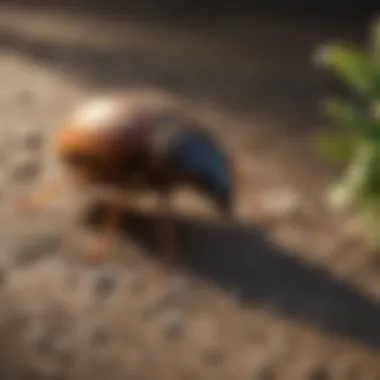

- Thermal Cameras: Useful for detecting heat patterns that may reveal hidden nests.
- Smart Traps: These traps provide alerts via app notifications when pests are detected.
The integration of technology offers property owners a new avenue for pest management. By utilizing innovative methods, homeowners can achieve more accurate assessments, preventing pests from gaining a foothold. However, it does require some upfront investment, which might not be feasible for everyone.
"A stitch in time saves nine." Spotting trouble early can save you money and stress later on.
Being aware of both visual cues and technological tools allows homeowners to holistically approach pest evaluation. This dual approach not only simplifies fear around infestations but also empowers homeowners to take action promptly before issues escalate.
Pest Control Methods
Pest control methods form the cornerstone of any effective extermination strategy. Understanding these methods gives homeowners the tools to tackle their pest issues head-on. The methods vary widely, each having its own set of benefits and considerations. Choosing the right one for your situation can mean the difference between a temporary fix and a lasting solution, making it crucial for informed decision-making. Whether opting for chemical extermination, natural solutions, or a blend of both, knowing what works best in Greensboro's unique pest environment can guide the process.
Chemical Extermination Techniques
Chemical extermination techniques typically rely on pesticides to eliminate unwanted pests. While effective, these methods can raise eyebrows among those conscious of the potential hazards associated with chemical exposure. One can find a range of products designed for various pests, with formulations that target anything from insects to rodents. The effectiveness of these chemicals is certainly a plus; however, their impact on the environment and health is a significant consideration.
Before proceeding with chemical methods, it’s essential to do thorough due diligence. Homeowners should inquire about the specific chemicals being used and the safety measures in place during treatment. Furthermore, proper application is crucial, as improper use can lead to residue lingering longer than desirable, potentially posing risks to children and pets. In a nutshell, chemical extermination can offer immediate results, but one must weigh these against safety aspects.
Natural Pest Control Solutions
Natural pest control solutions have gained traction in recent years, especially among those who seek greener alternatives. These methods typically involve using non-toxic substances to deter or eliminate pests. The appeal of these solutions often lies in their relative safety for humans, pets, and the surrounding environment.
Essential Oils
Essential oils present a fascinating segment of natural pest control that deserves attention. Their aromatic compounds aren’t only pleasant; many have properties that repel pests efficiently. For instance, peppermint oil is notable for keeping mice at bay, while lavender oil is reputed for warding off mosquitoes. Homeowners appreciate essential oils as they offer a versatile and pleasant-smelling alternative to harsh chemicals.
What sets essential oils apart is their ability to serve dual purposes. Beyond pest control, they can enhance the home’s ambiance, creating a fragrant environment. While their efficacy can vary against different pests, they generally are a beneficial choice for those looking to opt for something more natural. However, a drawback is that these solutions often require more frequent application to maintain their effectiveness, as their potency can diminish over time.
Biological Control
Biological control is another interesting avenue in natural pest management. This strategy employs natural predators or parasites to keep pest populations in check. For example, ladybugs are often introduced into gardens to feast on aphids, providing an organic solution that helps maintain balance in the ecosystem.
The beauty of biological control lies in its minimal environmental impact. Since it relies on existing natural systems, it’s generally a sustainable and long-term option for pest management. However, it is not without challenges; the success of this method can depend on the particular pest species involved and their predators’ availability. This unpredictability may make biological control less appealing for those seeking swift results when dealing with an infestation.
Integrated Pest Management Strategies
Integrated Pest Management (IPM) strategies hinge on a combination of approaches tailored to specific pest issues. This method emphasizes long-term prevention coupled with environmentally sensitive solutions. IPM can utilize a mix of chemical, natural, and cultural practices. Such a holistic approach is particularly beneficial, as it minimizes reliance on any single method, thus reducing potential resistance issues in pests over time. Homeowners can benefit from this by ensuring their strategies are responsive to their unique situations, allowing them to navigate pest control with more precision and effectiveness.
Choosing the Right Exterminator
When it comes to dealing with pest issues, the choice of exterminator can make or break the situation. With countless options in Greensboro, it's vital to narrow down the field efficiently and effectively. You deserve a specialist who understands both the pests and the unique challenges that local environments present. This guide dives deep into what characteristics to inspect and the right questions to ask, ensuring that you can make a well-informed decision to safeguard your home from unwelcome invaders.
Qualities of a Professional Exterminator
Selecting a pest control expert isn’t just about choosing someone who can spray a few chemicals around your property. It requires a keen eye for detail and understanding of the broader pest control landscape. Here are essential qualities to look for:
- Licensing and Certification: Ensure your exterminator holds the necessary licenses issued by the state of North Carolina. This indicates they have the required training and are knowledgeable about local pest management laws.
- Experience and Expertise: A seasoned exterminator brings invaluable expertise. Check how long they've been in operation. Companies that have weathered the storm of different pest problems will likely have better strategies tailored to your needs.
- Customer Service: A professional exterminator should be approachable and ready to answer questions. Their responsiveness and willingness to explain their methods can tell you a lot about their professionalism.
- Technology-Driven Solutions: In today’s world, effective pest control relies on modern techniques and tools. Exterminators should utilize technology for inspections, monitoring, and even executing traps and bait systems.
- Reputation: Look for online reviews, ask for recommendations from friends or family, or check platforms such as Reddit for real customer experiences. A good reputation among the local community is often a strong indicator of reliability.
- Customized Plans: Beware of exterminators who offer one-size-fits-all solutions. A professional will assess your specific pest problem and propose a tailored plan that addresses your unique situation.
Questions to Ask Before Hiring
Before signing on the dotted line, it’s crucial to ask the right questions. This not only ensures that the exterminator meets your needs but also protects your home from potential further invasions. Here are some essential questions to consider:
- What is your treatment approach?
- Can you provide references or testimonials?
- What’s included in the service contract?
- What precautions do you take to ensure safety?
- Do you offer guarantees?
- What is the expected timeline for treatment?
- Understanding their methods shows whether they favor commercial chemicals over natural options, and it could resonate with your personal values.
- A reputable exterminator should gladly share contact information of past clients or point you toward online reviews. Talking to past clients gives you insight into their reliability and effectiveness.
- Details matter here. What is covered, how many visits are included, and what follow-up support is available after initial treatments? Knowing the ins and outs of the contract helps avoid surprises later.
- Whether you have pets or kids at home, safety should be a priority. Ask how they minimize risks associated with their treatments.
- Some companies may guarantee their work for a certain period. If pests return within that time frame, will they return for free?
- Knowing how long the process will take helps with planning, especially if adjustments to your lifestyle are necessary during treatments.
Choosing the right exterminator isn't just about fighting pests today; it's about securing your home for the long term. With the right information at your fingertips, you can lay waste to those little nuisances while ensuring your living space remains safe and sound.
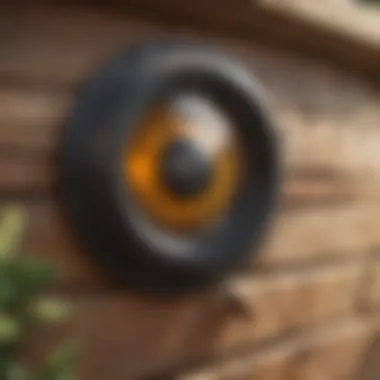

Post-Extermination Best Practices
Ensuring a pest-free home doesn’t end with extermination. In fact, what comes after is just as crucial. Proper post-extermination practices can make or break a homeowner's efforts to resettle in a space free from pests. Post-extermination best practices not only bolster the effectiveness of the initial treatments but also empower homeowners to take preventative steps against future invasions. This section sheds light on essential actions that need to be taken following pest control treatment, bringing to light their importance and benefits.
Cleaning After Extermination
The aftermath of pest extermination can leave many homeowners feeling at a crossroads. One question that often rattles in their minds is, "What do I do now?" Mopping floors and wiping surfaces might seem standard, but there's more to it. Cleaning after extermination is not merely a matter of aesthetics; it's about ensuring the effective removal of any remnants that may either trigger a new infestation or make the previous one a futile effort.
When you think about the types of chemicals and pest droppings involved, proper cleaning becomes paramount. Here are crucial steps to consider:
- Ventilation: Open windows and doors to allow fresh air in. This helps dissipate any lingering chemical residues and reduces unpleasant odors.
- Surface Cleaning: Wipe down surfaces with a mixture of warm water and mild detergent, ensuring to target corners and areas that might go unnoticed, as these can harbor remnants.
- Deep Cleaning Priority: Carry out a more thorough cleaning process for areas that pests frequented. Think cabinets, under sinks, and behind appliances.
It’s important to remember that not all cleaning products pair well with pest control chemicals. Avoid mixing substances unless you're certain it’s safe. This will mitigate the risk of chemical reactions that may lead to hazards.
"An ounce of prevention is worth a pound of cure." Taking the time to clean properly can save you from future headaches.
Monitoring for Future Infestations
Cleaning is just part of the post-extermination puzzle. The next piece is vigilance. Keeping an eye out for signs of potential future infestations not only provides peace of mind but can also lead to prompt intervention if pests decide to return.
Keep these practices in mind while monitoring your home:
- Regular Inspections: Schedule routine checks for signs of new pests. Look in corners, behind large furniture, and in dark or damp areas. If the eyes don't catch it, the nose often does. Watch out for unusual smells.
- Behavioral Awareness: Notice changes in your home. For example, doors that won’t budge when they typically do or sounds of scurrying at odd hours. These might be subtle cues that warrant a closer look.
- Recording Findings: Maintain a log of any signs of pests, which can help you recognize patterns or recurring issues and provide valuable information to pest control professionals if necessary.
Finally, do not overlook the significance of your neighbors. Sometimes pests don’t respect property lines. Discussing pest control with them can enhance overall community vigilance. A coherent neighborhood strategy can serve as a fortress against unwanted visitors.
By implementing the above post-extermination best practices, homeowners can pave the way to a healthier, happier living space. Awareness and cleanliness go hand in hand in fortifying your humble abode against future pest troubles.
Preventative Measures
Preventing pest invasions before they begin is paramount for homeowners in Greensboro. The significance of preventative measures cannot be overstated. By developing a solid strategy, you not only protect your home from being overrun by unwanted critters but also save on costly extermination fees down the road. Think of these measures as a form of good insurance against the nuisances that can disrupt day-to-day life, not to mention potential health risks associated with rodents and insects.
Home Maintenance Tips
Sealing Entry Points
One of the cornerstones of pest prevention is sealing entry points. This refers to the practice of identifying and blocking off any small openings around your home—think cracks in walls, gaps around windows, or spaces where pipes enter your house. Addressing these vulnerabilities helps in keeping pests outside where they belong.
The key characteristic of sealing entry points is its straightforward nature. It does not involve complex tools or special expertise; most homeowners can accomplish it with a bit of caulk, a hammer, or some weather stripping. This makes it a popular choice for those aiming for effective pest control without the need for constant professional intervention.
In terms of unique features, sealing entry points is advantageous because it not only deters pests but also improves energy efficiency by reducing drafts. However, it requires regular upkeep as wear and tear might necessitate occasional resealing, particularly in areas exposed to the elements.
Regular Inspections
Another essential aspect of preventative measures is conducting regular inspections throughout your property. This ensures that homeowners catch potential pest issues early before they spiral out of control. Regular inspections involve checking for signs of infestation, such as droppings, nests, or damage to structures.
The key feature of this practice lies in its proactive approach. Rather than waiting for a problem to signal itself with noise or numbers, routine inspections allow you to be steps ahead. This is a beneficial strategy since identifying issues early can minimize damage and enhance the overall well-being of your home environment.
Unique to this method is that it encourages familiarity with your living space. By getting to know your house's little quirks and corners, you make it easier to spot irregularities. However, the downside might be the time it takes to carry out thorough checks. Scheduling regular inspections can often slip down the priority list of a busy household.
Education and Awareness
Promoting education and awareness about pest control is vital. It fosters an informed community that understands the risks and signs of pest infestations. When homeowners know what to look for—whether it’s an unusual increase in pest activity or the unmistakable signs of an infestation—they are better equipped to act swiftly. Knowledge-sharing can save much headache, stress, and expense over time.
Equipping oneself with knowledge about local pest behavior, seasonal trends, and effective preventative measures enhances the ability to safeguard your home. Resources such as community workshops or local pest control seminars can serve as great platforms for learning. Homeowners should stay updated by engaging with forums and articles that might provide the latest strategies for keeping their homes pest-free.
Epilogue
Understanding the nuances of extermination services is vital for a successful pest management strategy in Greensboro. This final section wraps together multiple threads discussed in the article, providing clarity and direction for homeowners navigating these often turbulent waters. In a city like Greensboro, where various pests can quickly become a significant problem, having a solid grasp on the pest control landscape leads to informed decisions that can save time, money, and stress.
Whether it's the threat posed by rodents or the hidden dangers of bed bugs, recognizing the signs and knowing when to seek professional help can mean the difference between a minor nuisance and a full-blown infestation. More than merely providing a service, professional exterminators bring expertise, experience, and peace of mind—ensuring that homeowners are not left in the dark when it comes to pest problems.
Recap of Key Points
- Understanding Common Pests: It’s crucial to identify pests that frequently invade homes in Greensboro, such as termites, rodents, and bed bugs. Each brings unique threats and challenges.
- Evaluating Pest Problems: Homeowners should be vigilant about signs of pest infestations. A thorough inspection, whether self-conducted or with professional assistance, can detect problems early.
- Treating Infestations: Familiarity with various extermination methods, including chemical and natural approaches, allows for a tailored solution that best fits the homeowner’s needs.
- Choosing the Right Exterminator: Professionals must be vetted for their qualifications and experience. Asking the right questions ensures you get the best service possible.
- Post-Extermination Practices: Maintaining cleanliness and ongoing monitoring reduces the likelihood of future infestations and prolongs the effectiveness of treatment.
- Preventative Measures: Taking proactive steps, like proper home maintenance and staying informed about pest control, fortifies a home's defenses against pests.
Call to Action for Homeowners
Now that you’re equipped with valuable knowledge about pest control services, the next logical step is action. Don’t wait for a minor annoyance to spiral out of control. If you suspect any pest activity in your home, it’s time to get moving. Remember the following:
- Conduct Inspections: Regular checks around the home can uncover signs of pests early, allowing you to take timely action.
- Stay Informed: Continually educate yourself on pest control methods and emerging pest problems. Knowledge is power, and understanding the landscape aids in effective management.
- Engage Professionals: When in doubt, reach out to a pest control expert. They can provide comprehensive assessments and tailored solutions, ensuring your home remains a safe haven.
- Maintain Vigilance: Even after treatment, maintain routines of cleanliness and inspection to prevent future issues. This persistent outlook is crucial in maintaining a pest-free environment.
"An ounce of prevention is worth a pound of cure."
Your home is your sanctuary. Don’t let pests take over. Armed with the right information and a proactive stance, you can ensure your living space remains free from unwelcome guests.


